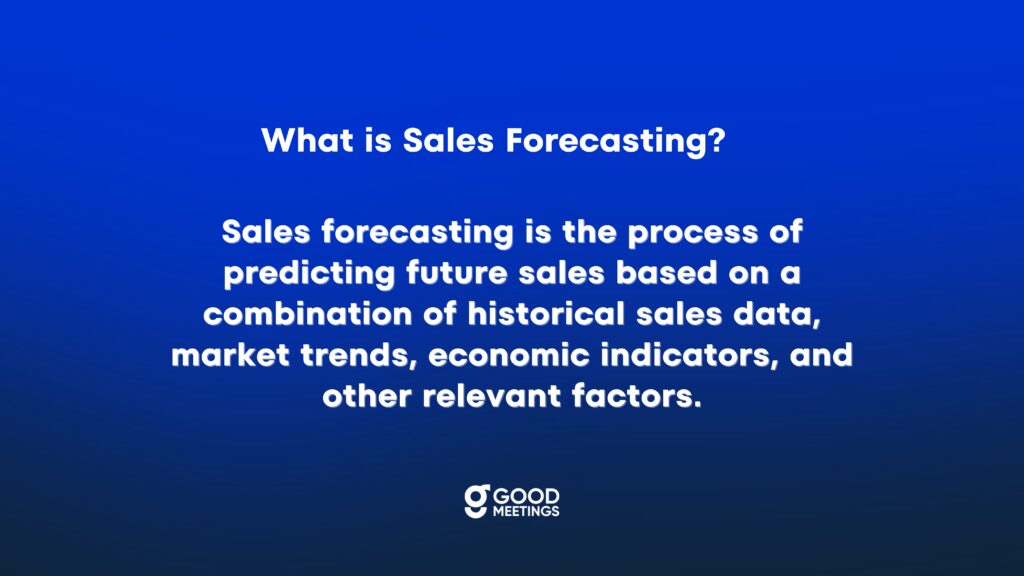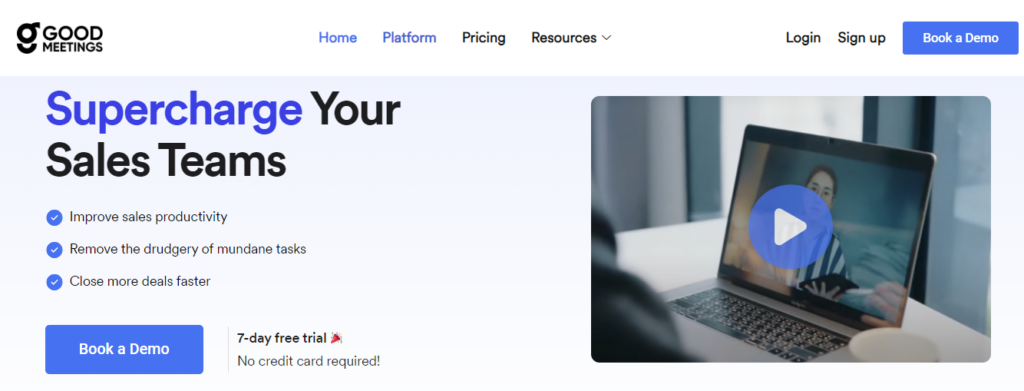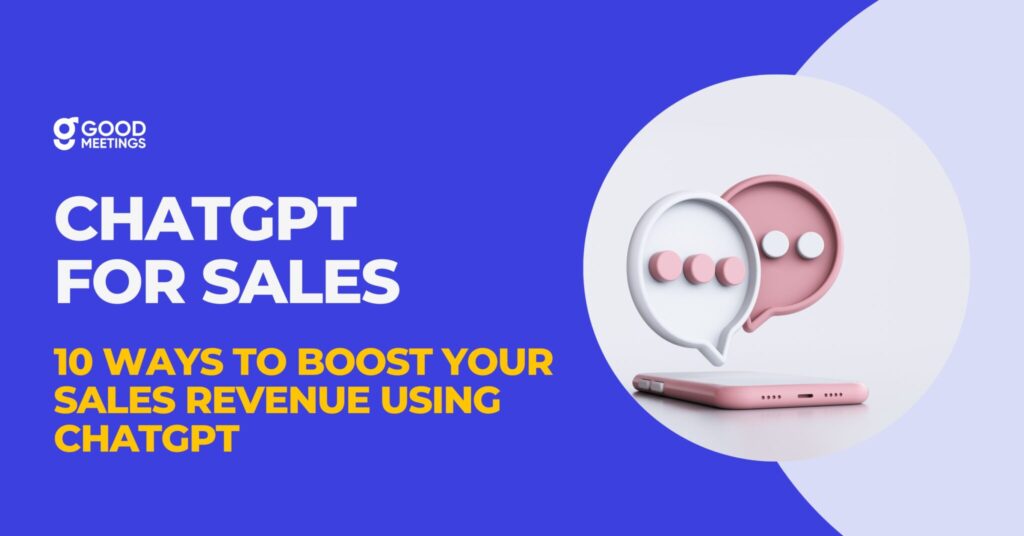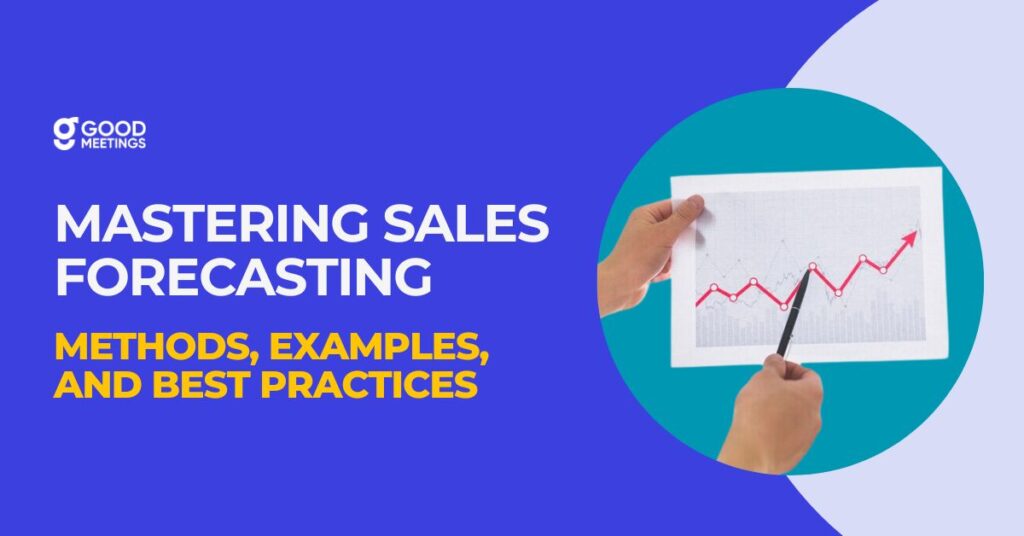Table of contents
Sales forecasting is crucial for any business looking to stay ahead of the curve. With accurate sales forecasts, you can gain insights into future revenue, plan better, and drive your company toward growth.
But the big question is — how do you effectively create a sales forecast that truly reflects your business’s potential and market conditions? Well, you’re about to find out!
In this blog post, we’ll define what sales forecasting is, explore its benefits, and delve into the various methods you can use to create accurate sales forecasts. We’ll also share best practices that can help you refine your forecasting skills.
Ready to master the art of sales forecasting? Let’s dive in!
What is Sales Forecasting?

Source: Goodmeetings
Sales forecasting is the process of predicting future sales based on a combination of historical sales data, market trends, economic indicators, and other relevant factors.
This strategic practice involves estimating the volume of sales a business expects to achieve over a specific period, such as a month, quarter, or year.
The primary objective of sales forecasting? It’s to provide a reliable basis for decision-making, enabling businesses to plan their operations, manage inventory levels, allocate resources efficiently, and set realistic financial goals.
Let’s check out why sales forecasting is important in more detail:
- Informed decision-making
Sales forecasting provides businesses with accurate data to make informed decisions regarding resource allocation, marketing strategies, and sales efforts. This ensures that the company’s resources are used efficiently to achieve maximum profitability.
- Resource allocation
By predicting future sales, companies can allocate their resources more effectively, ensuring that inventory, staffing, and production levels are aligned with anticipated demand. This helps in avoiding overproduction or stockouts, which in turn leads to cost savings.
- Financial planning and budgeting
Accurate sales forecasts are essential for financial planning and budgeting. They allow businesses to predict revenue streams, manage cash flow, plan for capital expenditures, and ensure financial stability. This will help them set realistic financial goals and prepare for future growth.
- Performance measurement
Sales forecasting enables businesses to set realistic sales targets and performance benchmarks. This motivates sales teams to stay focused & allows managers to track progress and identify areas for improvement. It also facilitates performance appraisals and incentive planning.
- Risk management
Forecasting helps in identifying potential risks and uncertainties in the market. By anticipating fluctuations in demand and market conditions, companies can develop contingency plans to mitigate risks and ensure business continuity.
- Market trend analysis
Analyzing market trends and incorporating them into sales forecasts allows businesses to stay ahead of the competition. It’ll assist them in identifying emerging opportunities and adjusting strategies to capitalize on market trends and consumer preferences.
- Operational efficiency
Sales forecasting improves operational efficiency by aligning production schedules, inventory management, and supply chain processes with anticipated demand. This reduces lead times, minimizes holding costs, and enhances overall operational performance.
- Customer satisfaction
By ensuring that products are available when and where customers want them, sales forecasting enhances customer satisfaction. Accurate forecasts help in meeting customer demand promptly & reducing the likelihood of stockouts or delays.
- Investor confidence
Aside from helping businesses keep their customers satisfied, reliable sales forecasts build investor confidence and support, as they demonstrate that the company has a clear understanding of its market and future revenue potential.
How to Create a Sales Forecast

Source: Goodmeetings
Want to create a comprehensive and accurate sales forecast that guides your business toward sustained growth and success? Here are the steps you need to follow:
1. Gather historical sales data
The first step in creating a sales forecast is to collect historical sales data. This data serves as the foundation for your forecast and helps identify trends and patterns in past sales performance.
Collect information on sales volumes, revenue, and other relevant metrics over a significant period, such as the past year or more.
By analyzing this historical data, you can better understand seasonal fluctuations, growth rates, and other factors that influence sales. This historical perspective is crucial for making accurate predictions about future sales.
2. Analyze market trends
Once you have your historical sales data, the next step is to analyze current market trends. This involves studying the broader economic environment, industry trends, and competitor activities.
Understanding market conditions helps you anticipate changes in demand and adjust your sales forecast accordingly.
For instance, if a new competitor enters the market or there’s a shift in consumer preferences, your forecast should reflect these potential impacts.
Staying informed about market trends ensures that your sales forecast is grounded in the current business landscape.
Related: 12 Best Sales Analytics Software To Measure Sales Performance
3. Set clear objectives
Before diving into the numbers, it’s important to set clear objectives for your sales forecast. Determine what you aim to achieve with the forecast — whether it’s setting sales targets, planning for expansion, or managing cash flow.
Clear objectives will guide the forecasting process and ensure that your efforts are aligned with your overall business goals.
Having specific, measurable objectives also helps you evaluate the success of your sales forecasting efforts and make necessary adjustments.
4. Choose a forecasting method
There are several methods to forecast sales, and choosing the right one depends on your business type, data availability, and objectives.
If you want to produce reliable and actionable sales forecasts, it’s important to select the appropriate method. We’ll talk about this more in the section to help you make the best choice.
5. Review & adjust
Once the initial forecast is developed, review it carefully. Compare the forecasted figures with historical performance and market expectations to check for consistency and accuracy.
Identify any discrepancies or anomalies and adjust the forecast as needed. This review process is crucial for refining the forecast and making it more accurate.
Involve key stakeholders, such as sales managers and financial analysts, to provide feedback and insights that can enhance the forecast’s reliability.
6. Implement & monitor
After finalizing the sales forecast, it’s time to implement it into your business planning. Use the forecast to set sales targets, allocate resources, and plan marketing strategies.
You need to regularly monitor actual sales performance against the forecasted figures to track progress and identify any deviations. This will help you make real-time adjustments and ensure that your business stays on track.
Related: AI in Sales Forecasting: Uses, Benefits & Best Practices
8 Sales Forecasting Methods & Examples
In this section, we’ll dive into 8 distinct sales forecasting methods by providing detailed explanations and practical examples for each.
By understanding these methods, you can select the most appropriate approach for your business.
1. Historical sales forecasting
Historical forecasting is a straightforward sales forecasting method that relies on past sales data to predict future sales.
This method assumes that historical sales patterns and trends will continue. By analyzing previous sales data over a specific period, businesses can identify seasonal trends, growth rates, and other recurring patterns.
This information is then used to project future sales. Historical forecasting is particularly useful for businesses with stable sales histories and predictable markets.
However, it may be less effective in rapidly changing industries or during significant market shifts. The simplicity of historical forecasting makes it accessible, but it should be used in conjunction with other methods to improve accuracy.
Example
A retail company, for instance, might use historical forecasting to predict holiday season sales.
By analyzing sales data from the past five years, the store identifies that sales typically increase by 30% in November and December compared to the rest of the year.
Plus, the data shows that specific product lines, such as winter coats and holiday-themed clothing, see a 50% spike during this period.
Using this historical data, the store forecasts a 30% overall sales increase for the upcoming holiday season and orders additional inventory of popular items accordingly.
This preparation ensures they meet customer demand and maximize sales opportunities during their busiest time of the year.
2. Opportunity stage forecasting
This next method predicts the likelihood of closing deals based on the current stage of each opportunity within the sales pipeline.
It involves assigning a probability of closing to each stage of the sales process. For instance, opportunities at the initial contact stage might be assigned a 10% probability of closing, while those at the negotiation stage might have a 70% probability.
By multiplying the value of each deal by its probability of closing and summing these values, businesses can estimate their future sales revenue.
This approach relies heavily on historical data to determine the probabilities and requires a well-defined sales process and a robust CRM system to track opportunities accurately.
Example
Consider a software company that uses opportunity stage forecasting to predict its quarterly sales. The company categorizes its sales pipeline into stages:
- Initial Contact (5% probability),
- Qualified (20% probability),
- Product Demo (50% probability),
- Proposal Sent (70% probability), and
- Final Negotiation (90% probability).
Suppose the company has the following deals in its pipeline:
- A $10,000 deal at the Qualified stage.
- A $20,000 deal at the Product Demo stage.
- A $15,000 deal at the Proposal Sent stage.
Using opportunity stage forecasting, the forecasted revenue would be calculated as follows:
- Qualified stage: $10,000 * 20% = $2,000
- Product Demo stage: $20,000 * 50% = $10,000
- Proposal Sent stage: $15,000 * 70% = $10,500
Summing these values gives a total forecasted revenue of $22,500 for the quarter.
3. Intuitive forecasting
Intuitive forecasting, also known as judgmental forecasting, is a qualitative approach that relies on the expertise, experience, and subjective judgment of individuals or groups to predict future sales or business outcomes.
Unlike quantitative methods that depend on historical data and statistical models, intuitive forecasting uses personal insights and gut feelings to make predictions.
This method is particularly useful in situations where there is a lack of historical data or in rapidly changing industries where past data may not be reliable.
Intuitive forecasting can be highly flexible, as it allows experts to incorporate real-time information and adjust their forecasts based on their deep understanding of the market and customer behavior.
One the flip side, it can also be subjective and prone to biases. This is why it’s essential to complement it with other forecasting methods for greater accuracy.
Example
Consider a B2B SaaS company that provides customer support software and wants to forecast future sales.
The company gathers a group of experts, including sales managers, customer success managers, and product specialists, who have extensive knowledge of the market, industry trends, and customer behavior.
During an intuitive forecasting session, these experts discuss various factors that may impact future sales, such as the competitive landscape, economic conditions, and customer feedback.
They might predict increased sales due to a new product feature or anticipate a slowdown due to economic uncertainty.
Based on their collective insights and intuition, the experts generate a forecast for future sales. While this forecast is subjective, it’s grounded in the practical experience and market knowledge of the participants.
4. Top-down forecasting
Top-down forecasting is a strategic sales forecasting method that begins with an analysis of the total market size and works down to estimate the specific company’s sales.
This approach starts by evaluating the Total Addressable Market (TAM), which represents the maximum revenue opportunity available for a particular product or service within a defined market.
Next, the company estimates its potential market share based on competitive positioning, brand strength, product differentiation, and overall market strategy.
By applying this market share percentage to the TAM, businesses can derive their forecasted revenue.
This forecasting method is particularly useful for companies entering new markets or those without extensive historical sales data, as it provides a broad market perspective that can guide strategic planning and resource allocation.
Example
Imagine a tech startup aiming to enter the global cloud computing market. The company begins by assessing the TAM, which research indicates is valued at $500 billion.
Based on competitive analysis and market positioning, the startup estimates it can capture a 1% market share in its first year.
By applying this market share percentage, the company forecasts annual revenue of $5 billion (1% of $500 billion).
5. Bottom-up forecasting
Next is bottom-up forecasting, a detailed and granular approach to predicting sales that starts from the smallest unit of measurement within a company and builds up to the total revenue forecast.
This method begins with the analysis of individual components such as products, sales representatives, or customer segments.
Each unit’s performance is estimated based on historical data, anticipated demand, and other relevant factors.
These individual forecasts are then aggregated to provide a comprehensive picture of the company’s expected sales.
Bottom-up forecasting provides a realistic and data-driven view of future sales, as it considers the unique contributions and potential of each segment.
This approach is particularly beneficial for companies with diverse product lines or multiple sales teams, as it ensures that all aspects of the business are accounted for in the forecast.
Example
Consider a consumer electronics company that uses bottom-up forecasting to predict its annual sales. The company has three main product lines: smartphones, tablets, and laptops.
Each product line has dedicated sales teams responsible for different regions. The company collects sales data from each team, estimating the sales for smartphones, tablets, and laptops based on historical sales figures, current market trends, and sales pipeline data.
For instance, based on their pipeline and market analysis:
- the smartphone team forecasts $50 million in sales,
- the tablet team projects $30 million, and
- the laptop team estimates $40 million.
These forecasts are further broken down by region, with each regional team providing their estimates.
The combined data from all teams and regions is aggregated to create the overall sales forecast. In this case, the company expects total sales of $120 million for the year.
6. Length of sales cycle forecasting
This sales forecasting method estimates future sales based on the average duration it takes for a lead to progress through the sales cycle.
It relies on historical data to determine the typical time frame from initial contact with a prospect to closing the deal.
By understanding the average length of the sales cycle, businesses can predict when current opportunities are likely to close.
This method is objective as it uses actual data rather than subjective inputs from sales representatives. It’s particularly useful for businesses with well-documented sales processes and consistent sales cycles.
Example
Imagine a software company with an average sales cycle of 90 days. This company tracks its sales cycle length by summing the total number of days it took to close each deal over a specific period and then dividing by the number of deals closed.
Suppose they recently closed five deals with the following durations: 80, 85, 90, 95, and 100 days. The total days would be 450, and dividing this by five results in an average sales cycle of 90 days.
If a new lead has been in the pipeline for 45 days, the company might forecast that there’s approximately a 50% likelihood of closing this deal within the next 45 days.
7. Multivariable analysis forecasting
Multivariable analysis forecasting uses multiple variables to predict future sales.
Unlike simpler methods that rely on a single factor, multivariable analysis considers a range of factors including market trends, economic conditions, sales cycle length, opportunity stage probability, and individual sales rep performance.
By analyzing the interplay between these variables using statistical models such as regression analysis or machine learning algorithms, businesses can develop more accurate sales forecasts.
However, it requires extensive data collection, advanced analytical tools, and a high level of expertise to implement effectively.
Example
Let’s consider a consumer electronics company that uses multivariable analysis forecasting to predict quarterly sales for its latest smartphone.
The company considers several variables:
- historical sales data,
- marketing expenditures,
- economic indicators like GDP growth,
- seasonal trends (higher sales during holiday seasons),
- customer reviews, and
- competitor pricing strategies.
By employing a multivariable regression model, the company quantifies the impact of each variable on sales.
For instance, the model might reveal that a 10% increase in marketing spend correlates with a 5% increase in sales, while positive customer reviews contribute an additional 3% to sales growth.
After inputting the current values for these variables into the model, the company forecasts a 15% increase in sales for the upcoming quarter.
8. Lead value forecasting
Lead value forecasting evaluates the potential revenue from each lead in your sales pipeline based on their assigned monetary value and conversion probability.
This method involves calculating the expected revenue from leads by multiplying the sales value (the amount of money expected from a successful sale) by the lead-to-sale conversion rate (the probability that a lead will convert into a customer).
It allows businesses to forecast future sales by summing the values of all active leads in the pipeline, offering a more granular and dynamic view of potential revenue.
Example
Imagine a SaaS company that has two primary sources of leads: demo requests and paid advertising.
Historical data shows that demo request leads typically close at $2,000 per sale with a conversion rate of 30%, giving each demo lead a value of $600 ($2,000 x 0.3).
In contrast, leads from paid advertising close at $1,000 per sale with a 10% conversion rate, resulting in a lead value of $100 ($1,000 x 0.1).
If the company currently has 40 demo leads and 100 paid advertising leads in its pipeline, the total forecasted revenue would be $34,000 (40 x $600 + 100 x $100).
Related: 10 Best Sales Intelligence Software For 2024
6 Sales Forecasting Best Practices
Here are some best practices that can help you refine your forecasting methods, improve communication across teams, and leverage data more effectively.
1. Establish a clear sales process
Having a standardized and well-documented sales process is essential for accurate sales forecasting.
This ensures that every sales team member follows the same steps and uses consistent terminology when moving leads through the sales funnel.
By clearly defining each stage of the customer lifecycle—from lead generation to closing deals—businesses like yours can reduce subjectivity and improve the precision of their forecasts.
2. Use multiple forecasting methods
Relying on a single forecasting method can limit the accuracy of your sales predictions. Instead, using a combination of methods can provide a more comprehensive and balanced view.
For example, combining historical data analysis with market research and opportunity stage forecasting can help cross-verify the predictions and highlight any discrepancies.
Each method has its strengths and weaknesses, and leveraging multiple approaches allows you to capture a broader range of factors influencing sales.
This multi-method approach can mitigate the risks associated with relying solely on one type of data or analysis, leading to more robust and reliable forecasts.
3. Leverage the right tools
The use of advanced technology & tools can greatly enhance the accuracy and efficiency of sales forecasting.
CRM systems, AI-powered analytics, and forecasting software can automate data collection, analysis, and reporting.
What’s more, a conversational intelligence tool like Goodmeetings can improve your sales forecasting efforts by providing a wealth of actionable insights and automating key aspects of the sales process.

Source: Goodmeetings
With this AI-powered tool, you can:

Source: Goodmeetings
a. Capture meeting intel
Goodmeetings captures detailed data from every sales interaction by recording, transcribing, and summarizing your meetings.
This rich dataset provides a granular view of customer interactions, which can be analyzed to identify patterns and trends.
By understanding what was discussed during sales calls, businesses can better predict future sales outcomes based on the nature and content of these interactions.
Related: What is a Sales Discovery Call? – Questions, Process and Template
b. Automate processes
The platform’s ability to automate action items significantly reduces the administrative burden on sales reps, allowing them to focus more on selling rather than on mundane tasks.
Automated action items ensure that follow-ups are timely and consistent, leading to a more reliable sales pipeline.
c. Enhance decision-making with AI insights
Goodmeetings also provides deep analytics and sentiment analysis of sales interactions. This feature helps in understanding the emotional tone of customer conversations, which can be a predictor of deal success.
By analyzing sentiment trends across different stages of the sales cycle, businesses can identify which deals are more likely to close and adjust their forecasts accordingly.
What’s more, this tool offers real-time AI support during meetings to help sales reps navigate conversations more effectively and increase the likelihood of positive outcomes.
d. Integrate seamlessly with CRM systems
Goodmeetings’ deep CRM integration ensures that all data from sales meetings is seamlessly synced with the company’s CRM system.
This integration eliminates data silos and provides a unified view of customer interactions, deal progress, and sales pipeline health.
With a comprehensive and up-to-date dataset, businesses can generate more accurate sales forecasts that are informed by real-time data.
e. Boost sales performance with coaching
Goodmeetings provides both AI-based and live coaching. This can help sales reps refine their techniques and improve their effectiveness over time.
By continuously enhancing the skills of the sales team, businesses can expect more consistent sales performance, which in turn leads to more reliable sales forecasts.
The best part? You can try out Goodmeetings at no cost by taking advantage of its 7-day free trial offer!
GET IN TOUCH



